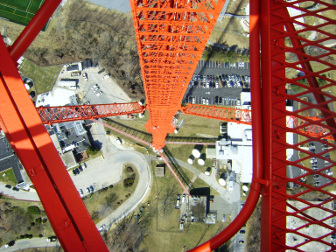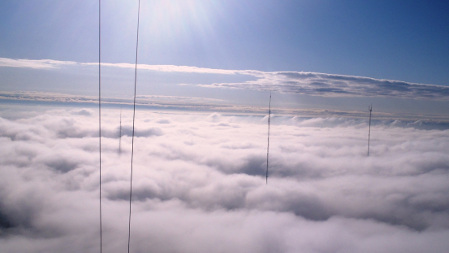Confessions Of A Tall-Tower Worker

Paul Fitts
ALEXANDRIA, VA.—Paul Fitts is one of the very few U.S. communications tower workers qualified to handle “tall” tower jobs, a skill that’s now very much in demand due to the on-going spectrum repack—by Fitts’ definition, “tall” is anything greater than 500-feet. At age 33, he’s also the chief operating officer of Vertical Technology Services, LLC, a firm specializing in the construction, inspection, remediation and rigging of tall television broadcast towers, and in his 13 years of ascending and descending towers belonging to numerous broadcast facilities and lessors, he’s certainly had his share of work-related experiences and has agreed to share some of them, along with his views on the on-going TV broadcast spectrum repack.
Asked about why he chose his particular line of work, Fitts explained that upon graduating from high school in 2002, he was undecided about what he wanted to do with his life.
“I [initially] worked as an assistant maintenance engineer at a 10-story high-rise,” said Fitts, noting that he soon decided he wasn’t cut out for it. “It was only for 10 months.”
It was at that time that several close high school friends who worked for a Frederick, Md., Tower service company, U.S. Tower, convinced Fitts to try out their line of work.

Just another typical day in a tall tower worker’s life—no boardroom meetings, and very few salespersons stop by to distract you.
“I knew I liked to climb since I was about 10,” he said, “I’d taken up rock climbing later on and decided to see if tower work wouldn’t be more rewarding than what I’d been doing. I was a little nervous for the first two days or so. After that it was OK. My first job was on a 400-foot tower in Baltimore. It was easy, all I had to do was snap in some cables.”
The professional video industry's #1 source for news, trends and product and tech information. Sign up below.
TOWER WORK ISN’T JUST MAKING ASCENTS AND DESCENTS
Fitts notes that there’s sometimes a misconception by the general public (and even tower owners themselves) that tower work only amounts to climbing and hanging antennas.
“We do tower inspections, looking at things like paint and corrosion, damaged tower structural members, guy line tension, whether or not a tower is plumb, the thickness of hollow members and also the condition of the foundation and anchors,” said Fitts, adding that many tower owners have an “out-of-sight, out-of-mind” attitude about guy line anchors and most of the anchor is below ground.

A tower worker’s job isn’t always hundreds of feet above the ground. It also involves occasional digging to look for the invisible “enemy”—rusty, corroded guy line anchors, such as these, which can topple a tower without warning.
“This is one of the first things we check,” said Fitts. “In some cases, we found some really serious corrosion has set in, undermining the integrity of the whole structure.”
A DANGEROUS PROFESSION?
When asked whether he viewed a workplace a quarter of a mile or more in the air as especially dangerous, Fitts observed that one could die just as easily from a 20-foot fall as in an uncontrolled descent from 2,000 feet.
“It’s only as dangerous as you make it,” he said. “There are lots of safety regulations. These can make you safe enough if you follow them.”
Asked if he had had any close calls, Fitts answered in the negative, but did relate an experience at an Indianapolis job site that could have gone very badly.
“We had just set the lower part of a tower crane, and an unexpected storm came up,” said Fitts. “We got hit by a 70 mile-per-hour straight line wind. It was very scary for a while, but no one got hurt.”
TRAINING IS AN ESSENTIAL PART OF THE JOB
While the lack of a fear of heights, better than average manual dexterity and the ability to climb and function effectively while hundreds of feet above the ground are important attributes for workers in the tower erection and maintenance industry, they are only part of the skill set required, according to Fitts.
“Worker training in several areas is very important too,” said Fitts. “You have to know how to rig, the right way to handle a rescue if someone gets into trouble and also the safety procedures that must be followed when you’re doing tower work.”
While drawing up a detailed “plan of attack” and ensuring that all parties involved is important in any project, it is especially crucial when you’re high off the ground and working with antennas and other items weighing hundreds or thousands of pounds, Fitts noted. The consequences of a slight misstep or the dropping of a hand tool, or even a bolt, while in the air, can have consequences much more severe than at ground level.

The view from a tower “candelabra” platform. Automobiles, satellite dishes and buildings take on an entirely different perspective when you’re seeing them hundreds of feet beneath you.
“You want to make sure that everything is completely thought out and rehearsed ahead of time,” said Fitts. Such planning even includes mapping and marking off the area in close proximity to the tower base, noting that this sometimes involves closing off employee parking areas at television stations. “Sometimes it’s hard to clear enough area on the ground to let us do what we have to do.”
GRAVITY ISN’T THE ONLY ENEMY
Fitts observed that keeping oneself safe from falls, mechanical injuries, too much sun, and RF exposure aren’t the only things a tower worker has to be vigilant about. Occasionally some of Mother Nature’s smaller creations also make life interesting.
“Bees and wasps sometimes like to nest in and around tower structures,” said Fitts, “We have to watch out for these,” noting that getting away from stinging creatures is a lot easier to do if you weren’t “tied-on” to a tower structure.
Flying insects with stingers aren’t the only pests that tower workers have to deal with either. Fitts recalls that he and his crew once faced a potentially life-threatening “invasion” while doing a job in Rayne, La.
“We were working on an 1,800-foot antenna there,” said Fitts. “There were rattlesnakes all over the place. We had to clear the snakes every day before we could start work.”

The weather may be dark and gloomy on the ground, but sunny and bright where the work is going on. A tall tower worker has to be prepared for just about everything.
NOT FOR EVERYONE, BUT…
Asked about what attracts people such as himself into choosing tower work as a career, Fitts was quick to reply.
“For some, it’s thrill-seeking—there’s definitely an adrenalin rush. The pay is good too. It starts fairly low, but you can advance very quickly in this field if you’re good. There’s also lots of travel, which appeals to some people.”
Would he choose tower work if he were starting over? “Absolutely,” he said. “There are few other occupations that I think I would enjoy as much.”
To Fitts, the most rewarding part of the job is a feeling of accomplishment and the knowledge that he’s doing something that few others do. “The real feeling of accomplishment comes when I’m watching over-the-air TV or listening to FM radio and knowing that I helped to make this possible.”
